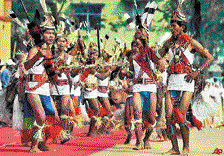Unique: ‘Firkal’ performance
No mention has been made of it in ancient treatises, history books, traveller’s account or even in archaelogical records. | Read more >>Older than Kalaripayattu, and even those martial art forms that trace its origins to China and Japan, Firkal is still very much a living martial art-based dance form, performed mainly by the Bhumij tribes of Chotanagpur area in Jharkhand.
The distressing part is that Firkal survives in just one obscure village, Janumdih, located at Potka block in East Singhbhum district of Jharkand. Only 25 Bhumij families residing in this village are familiar with this art, and are seemingly unaware of the fact that this tradition may die out soon, if no one steps up to carry it forward.
“This is literally the last frontier of Firkal. Even the tribals do not feel the need to perform anymore,” says Amitabh Ghosh of The Celluloid Chapter Art Foundation (TCCAF), a social service organisation in Jamshedpur, engaged in the revival and promotion of the dance.
Raghunath Sardar of Veer Adim Kherwar Samiti (VAKS), a group working with the tribals in Janumdih adds, “Till 16 years ago, Firkal used to be performed almost everyday. But now, even in the only village it survives, we are able to hold performances only five to six times a year.”
The reasons are obvious. Economic deprivation, degradation of land and the temptations of urban culture have led to large scale migration of tribals to greener pastures. The ones who are left behind have far more pressing problems to attend to, than that of the survival of a dance form that hardly anyone understands or appreciates.
Once in a while, the State Government holds Adivasi Utsavs in Jamshedpur where representatives of the Bhumij families are made to perform with other tribal dancers in the region, mainly as tourist attractions. It is a half-hearted, lackadaisical exercise that offers no incentive or dignity to dancers.
At first sight, Firkal appears to be like any other warrior dance performed by African tribes. […]
According to Sardar, the dance recitals were originally enactments of hunting scenes and self-defence, the focus being mainly of raw macho courage. Over time, however, the evolving lifestyle of the Bhumjis has led to the modification of dance movements.
“Over time, the dance movements have changed into a leisurely, recreational exercise rather than a ritualistic demonstration of courage. These dance steps are variously known as Bagh Taal , Birsa Munda Taal and Pahalbani Taal. The younger generation, however, seem to be unfamiliar with these dance steps,” says Sardar.
Ghosh points out, “Firkal, unlike other traditional martial art forms in the country, does not receive help or support from any quarter. It has virtually been pushed to the brink due to lack of resources.” […]
“TCCAF is the result of that initiative,” he explains. “We are creating a data base on Firkal.”
These volunteers have already created an impressive library comprising old Firkal song recordings, video tapes analysing basic body movements, interviews with artistes and detailed studies on various rhythms and beats. The Association for Indian Development in Minnesota, USA recently extended a handsome grant towards this project.
Source: The disappearing steps of tribal dance” by Shekher Phadnis, Maharaja Features, The Telegraph, 22 October 2011
Address : https://www.deccanherald.com/content/199806/disappearing-steps-tribal-dance.html
Date Visited: 7 July 2020
Reports in the Indian press | List of periodicals included in this search >>
Search tips
Combine the name of any particular state, language or region with that of any tribal (Adivasi) community.
Add keywords of special interest (music, poetry, dance just as health, sacred grove and biodiversity); learn about the rights of Scheduled Tribes such as the “Forest Rights Act” (FRA); and the United Nations “Declaration on the Rights of Indigenous Peoples”, “Universal Declaration of Human Rights”, “women’s rights”, or “children’s right to education”.
Ask a question that includes “tribal” or “Adivasi”, for instance: “Adivasi way of life better?” (or “tribal way of life worse?”)
Specify any particular issue or news item (biodiversity, bonded labour and human trafficking, climate change, ecology, economic development, ethnobotany, ethnomedicine, global warming, hunter-gatherers in a particular region or state, prevention of rural poverty, water access).
For official figures include “scheduled tribe ST” along with a union state or region: e.g. “Chhattisgarh ST community”, “Himalayan tribe”, “Scheduled tribe Tamil Nadu census”, “ST Kerala census”, “Particularly Vulnerable Tribal Group Jharkhand”, “PVTG Rajasthan”, “Adivasi ST Kerala”, “Adibasi ST West Bengal” etc.
In case the Google Custom Search window is not displayed here try the following: (1) toggle between “Reader” and regular viewing; (2) in your browser’s Security settings select “Enable JavaScript” | More tips >>
Note: hyperlinks and quotes are meant for fact-checking and information purposes only | Disclaimer >>
Related posts
See also
Audio | Santali Traditional and Fusion Songs: Ghosaldanga Bishnubati Adibasi Trust – West Bengal
Crafts and visual arts | Masks
India’s tribal, folk and devotional music: Secular and ceremonial songs
Memory of the World Programme – Unesco
Music and dance | Musicology | Adivasi music and the public stage by Jayasri Banerjee
Video | Banam lutes and fiddles of the Santal people – Jharkhand & West Bengal
Video | Celestial Dancers of Manipur
Video | Cultural traditions of the Halakki people – Karnataka
Video | Khasi musical heritage of Meghalaya
Video | Kota women’s dance: Shivaratri celebrations – Nilgiris – Tamil Nadu
Video | Santali video album “Ale Ato” (Our Village, Part 1 of 2) – West Bengal
Video | South Gujarat tribal music documentation by Bhasha – Gujarat
Video | Tribes in Transition-III: “Indigenous Cultures in the Digital Era”
Video | Safe contents for educational use on many topics (music, visual arts and more)
